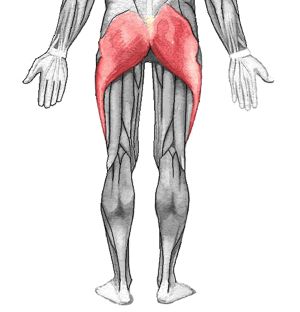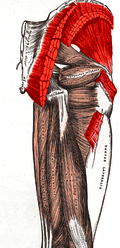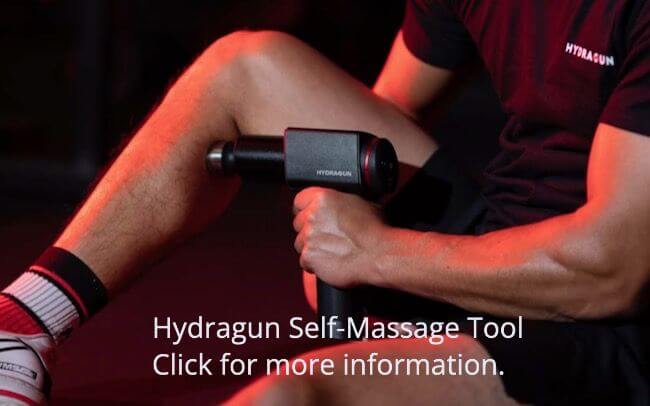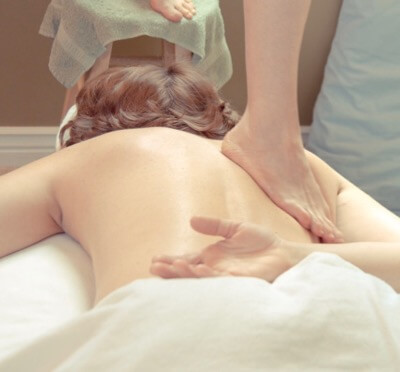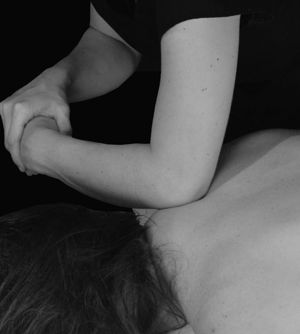- Home
- Benefits of Massage
- Butt Massage
As an Amazon Associate and affiliate with other programs, I may earn revenue from qualifying purchases through affiliate links. This does not affect the price you pay. Privacy Policy / Disclosures. This site is for educational purposes only.
Butt Massage Techniques to Help Relieve Back Pain
Tense buttock muscles can contribute to lower back and hip pain. Butt massage can range from Swedish massage techniques for overall relaxation to specific deep massage techniques to address pain and injury.
Let's look at the muscles of the buttocks and then some massage techniques for these muscles.
Understanding the Buttock Muscles
The gluteus maximus is the largest buttock muscle. To touch that muscle, place your hand directly on the back of your buttock (see the top image to the right). This muscle is one of the largest and strongest in the body.
The gluteus maximus is the largest buttock muscle. To touch that muscle, place your hand directly on the back of your buttock (see the top image to the right). This muscle is one of the largest and strongest in the body. The primary function of the gluteus maximus is hip extension (moving the thigh backward), especially when running and climbing hills. This muscle also helps extend the torso (think backbend) and rotate the thigh outward.
The muscle under and a little to the outside of the gluteus maximus is the gluteus medius. The gluteus medius rotates the thigh inward (medial rotation) and moves it away from the centerline of the body (abduction). This muscle is very important in walking and helps to stabilize your pelvis.
Underneath the gluteus medius is the small gluteus minimus, which assists gluteus medius.
At the outer edge of the buttock, on the side of the hip, lies the tensor fasciae latae, a small muscle that helps abduct and medially rotate the thigh. This muscle's tendon (the IT band) runs from the hip to the knee.
Underneath the larger gluteal muscles are six muscles referred to as the deep lateral rotators. The bottom image on the right shows the gluteus maximus cut away so that you can see the smaller underlying muscles. All of these muscles attach from various points on the pelvic bone to the head (greater trochanter) of the thigh bone (femur). They are responsible for outward rotation of the thigh.
The piriformis is the largest and most well known of the deep lateral rotator muscles. When the piriformis is too tight, it can compress the sciatic nerve, causing pain in the buttocks and down the back of the leg. This condition is called piriformis syndrome or false sciatica.
The other five deep lateral rotators are the obturator internus, obturator externus, gemellus superior, gemellus inferior, and quaratus femoris. All these muscles help stabilize your hip joint.
Butt Massage Videos
Butt & Glute Massage Techniques
- Use Swedish effleurage and petrissage techniques to warm up the muscles.
- Start at the top edge of the gluteus maximus and use your elbow to massage downward toward the thigh. Do this massage stroke over the entire muscle.
- Find the gluteus medius, located between the iliac crest (top of the hip bone) and the greater trochanter (knob-like protuberance) on the top outside of the thigh bone. Place your fingers into the muscle — either make circular motions or pull the muscle to take out the slack.
- 4Massage the deep lateral rotators by locating the greater trochanter and moving in a fan-like pattern toward the sacrum.
Also see back massage techniques.
Image Credits: Gluteus Maximus CC-BY-SA-3.0], via Wikimedia Commons and Cutaway illustration is public domain via Wikimedia Commons
